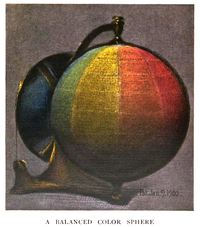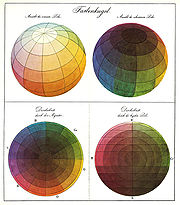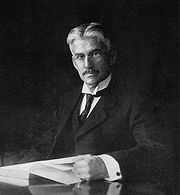
Munsell color system
Encyclopedia

Colorimetry
Colorimetry is "the science and technology used to quantify and describe physically the human color perception."It is similar to spectrophotometry, but is distinguished by its interest in reducing spectra to the physical correlates of color perception, most often the CIE 1931 XYZ color space...
, the Munsell color system is a color space
Color space
A color model is an abstract mathematical model describing the way colors can be represented as tuples of numbers, typically as three or four values or color components...
that specifies color
Color
Color or colour is the visual perceptual property corresponding in humans to the categories called red, green, blue and others. Color derives from the spectrum of light interacting in the eye with the spectral sensitivities of the light receptors...
s based on three color dimensions: hue
Hue
Hue is one of the main properties of a color, defined technically , as "the degree to which a stimulus can be describedas similar to or different from stimuli that are described as red, green, blue, and yellow,"...
, value (lightness
Lightness (color)
Lightness is a property of a color, or a dimension of a color space, that is defined in a way to reflect the subjective brightness perception of a color for humans along a lightness–darkness axis. A color's lightness also corresponds to its amplitude.Various color models have an explicit term for...
), and chroma (color purity). It was created by Professor Albert H. Munsell
Albert Henry Munsell
Albert Henry Munsell was an American painter, teacher of art, and the inventor of the Munsell color system.He was born in Boston, Massachusetts, attended and served on the faculty of Massachusetts Normal Art School, and died in nearby Brookline.As a painter, he was noted for seascapes and...
in the first decade of the 20th century and adopted by the USDA as the official color system for soil
Soil
Soil is a natural body consisting of layers of mineral constituents of variable thicknesses, which differ from the parent materials in their morphological, physical, chemical, and mineralogical characteristics...
research in the 1930s.
Several earlier color order systems had placed colors into a three dimensional color solid
Color solid
A color solid is the three-dimensional representation of a color model, an analog of the two-dimensional color wheel. The added spatial dimension allows a color solid to depict an added dimension of color variation...
of one form or another, but Munsell was the first to separate hue, value, and chroma into perceptually uniform and independent dimensions, and was the first to systematically illustrate the colors in three dimensional space. Munsell’s system, particularly the later renotations, is based on rigorous measurements of human subjects’ visual responses
Color vision
Color vision is the capacity of an organism or machine to distinguish objects based on the wavelengths of the light they reflect, emit, or transmit...
to color, putting it on a firm experimental scientific basis. Because of this basis in human visual perception, Munsell’s system has outlasted its contemporary color models, and though it has been superseded for some uses by models such as CIELAB (L*a*b*) and CIECAM02
CIECAM02
Published in 2002 by the CIE Technical Committee 8-01 , as of 2008 CIECAM02 is the most recent color appearance model ratified by the CIE, and the successor of CIECAM97s.| quote=The CIECAM97s model was adopted by the CIE in 1997 for color imaging applications. It includes forward and reverse modes...
, it is still in wide use today.
Explanation

Cylindrical coordinate system
A cylindrical coordinate system is a three-dimensional coordinate systemthat specifies point positions by the distance from a chosen reference axis, the direction from the axis relative to a chosen reference direction, and the distance from a chosen reference plane perpendicular to the axis...
in three dimensions as an irregular color solid
Color solid
A color solid is the three-dimensional representation of a color model, an analog of the two-dimensional color wheel. The added spatial dimension allows a color solid to depict an added dimension of color variation...
: hue, measured by degrees around horizontal circles; chroma, measured radially outward from the neutral (gray) vertical axis; and value, measured vertically from 0 (black) to 10 (white). Munsell determined the spacing of colors along these dimensions by taking measurements of human visual responses. In each dimension, Munsell colors are as close to perceptually uniform as he could make them, which makes the resulting shape quite irregular. As Munsell explains:
Hue
Each horizontal circle Munsell divided into five principal hues: Red, Yellow, Green, Blue, and Purple, along with 5 intermediate hues halfway between adjacent principal hues. Each of these 10 steps is then broken into 10 sub-steps, so that 100 hues are given integer values. Two colors of equal value and chroma, on opposite sides of a hue circle, are complementary colorComplementary color
Complementary colors are pairs of colors that are of “opposite” hue in some color model. The exact hue “complementary” to a given hue depends on the model in question, and perceptually uniform, additive, and subtractive color models, for example, have differing complements for any given color.-...
s, and mix additively
Additive color
An additive color model involves light emitted directly from a source or illuminant of some sort. The additive reproduction process usually uses red, green and blue light to produce the other colors. Combining one of these additive primary colors with another in equal amounts produces the...
to the neutral gray of the same value. The diagram below shows 40 evenly spaced Munsell hues, with complements vertically aligned.
Value
Value, or lightnessLightness (color)
Lightness is a property of a color, or a dimension of a color space, that is defined in a way to reflect the subjective brightness perception of a color for humans along a lightness–darkness axis. A color's lightness also corresponds to its amplitude.Various color models have an explicit term for...
, varies vertically along the color solid, from black (value 0) at the bottom, to white (value 10) at the top. Neutral grays lie along the vertical axis between black and white.
Several color solids before Munsell’s plotted luminosity from black on the bottom to white on the top, with a gray gradient between them, but these systems neglected to keep perceptual lightness constant across horizontal slices. Instead, they plotted fully saturated yellow (light), and fully saturated blue and purple (dark) along the equator.
Chroma
Chroma, measured radially from the center of each slice, represents the “purity” of a color, with lower chroma being less pure (more washed out, as in pastels). Note that there is no intrinsic upper limit to chroma. Different areas of the color space have different maximal chroma coordinates. For instance light yellow colors have considerably more potential chroma than light purples, due to the nature of the eyeHuman eye
The human eye is an organ which reacts to light for several purposes. As a conscious sense organ, the eye allows vision. Rod and cone cells in the retina allow conscious light perception and vision including color differentiation and the perception of depth...
and the physics of color stimuli. This led to a wide range of possible chroma levels—up to the high 30s for some hue–value combinations (though it is difficult or impossible to make physical objects in colors of such high chromas, and they cannot be reproduced on current computer displays). Vivid soil colors are in the range of approximately 8.
Specifying a color
A color is fully specified by listing the three numbers for hue, value, and chroma. For instance, a fairly saturated purple of medium lightness would be 5P 5/10 with 5P meaning the color in the middle of the purple hue band, 5/ meaning medium lightness, and a chroma of 10 (see the swatch to the right).History and influence


Color solid
A color solid is the three-dimensional representation of a color model, an analog of the two-dimensional color wheel. The added spatial dimension allows a color solid to depict an added dimension of color variation...
to represent all colors was developed during the 18th and 19th centuries. Several different shapes for such a solid were proposed, including: a double triangular pyramid by Tobias Mayer
Tobias Mayer
Tobias Mayer was a German astronomer famous for his studies of the Moon.He was born at Marbach, in Württemberg, and brought up at Esslingen in poor circumstances. A self-taught mathematician, he had already published two original geometrical works when, in 1746, he entered J.B. Homann's...
in 1758, a single triangular pyramid by Johann Heinrich Lambert
Johann Heinrich Lambert
Johann Heinrich Lambert was a Swiss mathematician, physicist, philosopher and astronomer.Asteroid 187 Lamberta was named in his honour.-Biography:...
in 1772, a sphere by Philipp Otto Runge
Philipp Otto Runge
Philipp Otto Runge was a Romantic German painter and draughtsman. He made a late start to his career and died young, nonetheless he is considered among the best German Romantic painters.- Life and work :...
in 1810, a hemisphere by Michel Eugène Chevreul
Michel Eugène Chevreul
Michel Eugène Chevreul was a French chemist whose work with fatty acids led to early applications in the fields of art and science. He is credited with the discovery of margaric acid and designing an early form of soap made from animal fats and salt...
in 1839, a cone by Hermann von Helmholtz
Hermann von Helmholtz
Hermann Ludwig Ferdinand von Helmholtz was a German physician and physicist who made significant contributions to several widely varied areas of modern science...
in 1860, a tilted cube by William Benson
William Benson
William Benson was a talented amateur architect and an ambitious and self-serving Whig place-holder in the government of George I...
in 1868, and a slanted double cone by August Kirschmann in 1895. These systems became progressively more sophisticated, with Kirschmann’s even recognizing the difference in value between bright colors of different hues. But all of them remained either purely theoretical or encountered practical problems in accommodating all colors. Furthermore, none was based on any rigorous scientific measurement of human vision; before Munsell, the relationship between hue, value, and chroma was not understood.
Albert Munsell, an artist and professor of art at the Massachusetts Normal Art School, wanted to create a “rational way to describe color” that would use decimal notation instead of color names (which he felt were “foolish” and “misleading”), which he could use to teach his students about color. He first started work on the system in 1898 and published it in full form in A Color Notation in 1905.
The original embodiment of the system (the 1905 Atlas) had some deficiencies as a physical representation of the theoretical system. These were improved significantly in the 1929 Munsell Book of Color and through an extensive series of experiments carried out by the Optical Society of America
Optical Society of America
The Optical Society is a scientific society dedicated to advancing the study of light—optics and photonics—in theory and application, by means of publishing, organizing conferences and exhibitions, partnership with industry, and education. The organization has members in more than 100 countries...
in the 1940s resulting in the notations (sample definitions) for the modern Munsell Book of Color. Though several replacements for the Munsell system have been invented, building on Munsell’s foundational ideas—including the Optical Society of America
Optical Society of America
The Optical Society is a scientific society dedicated to advancing the study of light—optics and photonics—in theory and application, by means of publishing, organizing conferences and exhibitions, partnership with industry, and education. The organization has members in more than 100 countries...
’s Uniform Color Scales
OSA-UCS
In colorimetry, the OSA-UCS is a color space or chromaticity diagram first published in 1974 and developed by the Optical Society of America's Committee on Uniform Color Scales; presently the 1976 edition is adopted. It is based on and compatible with the CIE 1931 chromaticity diagram. Like the...
, and the International Commission on Illumination
International Commission on Illumination
The International Commission on Illumination is the international authority on light, illumination, color, and color spaces...
’s CIELAB (L*a*b*) and CIECAM02 color models—the Munsell system is still widely used, by, among others, ANSI
American National Standards Institute
The American National Standards Institute is a private non-profit organization that oversees the development of voluntary consensus standards for products, services, processes, systems, and personnel in the United States. The organization also coordinates U.S. standards with international...
to define skin and hair colors for forensic pathology
Forensic pathology
Forensic pathology is a branch of pathology concerned with determining the cause of death by examination of a corpse. The autopsy is performed by the pathologist at the request of a coroner or medical examiner usually during the investigation of criminal law cases and civil law cases in some...
, the USGS
United States Geological Survey
The United States Geological Survey is a scientific agency of the United States government. The scientists of the USGS study the landscape of the United States, its natural resources, and the natural hazards that threaten it. The organization has four major science disciplines, concerning biology,...
for matching soil
Soil
Soil is a natural body consisting of layers of mineral constituents of variable thicknesses, which differ from the parent materials in their morphological, physical, chemical, and mineralogical characteristics...
colors, in Prosthodontics
Prosthodontics
Prosthodontics, also known as dental prosthetics or prosthetic dentistry, is one of nine dental specialties recognized by the American Dental Association, Royal College of Dentists of Canada, and Royal Australasian College of Dental Surgeons...
during the selection of shades for dental restorations, and breweries for matching beer
Beer
Beer is the world's most widely consumed andprobably oldest alcoholic beverage; it is the third most popular drink overall, after water and tea. It is produced by the brewing and fermentation of sugars, mainly derived from malted cereal grains, most commonly malted barley and malted wheat...
colors.
External links
- Munsell Color Products, from X-RiteX-RiteX-Rite, Inc. is a manufacturer of color matching products, located in Grand Rapids, Michigan, United States. Their products include those used for matching paint colors. They also create products that regulate quality in the processing of film and x-rays....
, current owners of the Munsell Color CompanyMunsell Color CompanyThe Munsell Color Company was an American manufacturer of color references and teaching materials. It was founded by Albert Henry Munsell in 1917, to popularize and monetize his Munsell color system. In 1942, the board of the company sold its assets and created the Munsell Color Foundation with...
.- Munsell to L*a*b* Conversion Freeware, a Windows application for converting Munsell renotations to CIELAB coordinates.
- Munsell Color Science Laboratory at the Rochester Institute of TechnologyRochester Institute of TechnologyThe Rochester Institute of Technology is a private university, located within the town of Henrietta in metropolitan Rochester, New York, United States...
, an academic laboratory dedicated to color science, endowed by the Munsell Foundation.- Munsell renotation data in plain text format (from the 1940s Optical Society of America renotations).
- ApplePainter.com, a site explaining the Munsell color chart, including an edited version of Cleland’s book, A practical description of the Munsell color system.
- An explanation of the Munsell system at Adobe.com. Retrieved 13 August 2003
- A brief explanation at the site of the Japanese company Dainichiseika Color & Chemicals, including a nice diagram of the Munsell color solid.
- A flash-based Munsell Palette color-picker from web-design firm Triplecode (based on a version originally created at the MIT Media LabMIT Media LabThe MIT Media Lab is a laboratory of MIT School of Architecture and Planning. Devoted to research projects at the convergence of design, multimedia and technology, the Media Lab has been widely popularized since the 1990s by business and technology publications such as Wired and Red Herring for a...
). - ToyPalette from Loo & Cox, a web application for generating color palettes from images. Munsell color analysis of digital image.

